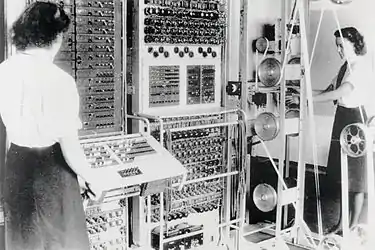Catherine Caughey
Catherine Mary Caughey MBE (née Harvey, 8 December 1923 – 12 April 2008) used Colossus computers for codebreaking at Bletchley Park during World War II.[1][2]
Early life
Catherine Mary Harvey was born in Eldoret, Kenya, on 8 December 1923,[3] and spent her early life on an isolated farm there.[2] She was educated in England, at St Mary's School, Calne in Wiltshire, and Harcombe House Domestic Science School, in Dorset.[3]
World War II service

Harvey was called up for war service in 1943.[1] After thorough interviewing and testing, she was chosen to work as a "Wren" in the Women's Royal Naval Service (WRNS), allocated to "Special Duties X" at Bletchley Park. Here from early 1944, she worked in the "Newmanry" (named after Max Newman[4]) using the Colossus computers for deciphering German High Command messages.[5] Later she was responsible for the teleprinter room in the Newmanry, where Tunny (Lorenz cipher) messages were received from the main intercept station located in Kent.
Post-war life
After the war, Harvey attended Dorset House in Oxford, trained as an occupational therapist. Once qualified, she worked at a psychiatric hospital in Oxford.
In 1950, she married Ron Caughey in Oxford.[3] Ron Caughey was awarded a fellowship to work at a children’s hospital in Philadelphia, United States. The couple then moved to Auckland, New Zealand, in 1952, living first in Epsom and later in Remuera. They had a son and a daughter. In 1975, Catherine Caughey became a naturalised New Zealand citizen.[6]
Ron Caughey died in 1975 before secrecy around wartime work at Bletchley Park was lifted in the same year, 30 years after the end of World War II,[2] followed by the declassification of the 1945 General Report on Tunny in 2000.[7]
Caughey was active in the Girl Guides in New Zealand, serving on the national council and executive, and in 1976 she was appointed honorary vice president for the Auckland province.[3] In 1978, she founded the Auckland Multicultural Society, and served as its president. In the 1994 New Year Honours, Caughey was appointed a Member of the Order of the British Empire, for services to the community.[8]
Caughey published an autobiographical book World Wonderer in the form of her diaries, which was approved by the British Ministry of Defence.[9] She also contributed to a chapter on bombes in The Turing Guide on Alan Turing that appeared posthumously in 2017.[10] She died in Auckland on 12 April 2008, and her body was cremated at Purewa Crematorium.[11]
Publications
- Caughey, Catherine M. (1994). World Wanderer. Auckland: Catherine Caughey. (autobiography)
References
- Copeland, Jack; Bowen, Jonathan; Sprevak, Mark; Wilson, Robin; et al. (2017). "Notes on Contributors". The Turing Guide. Oxford University Press. p. 476. ISBN 978-0198747833.
- "Catherine Caughey's remarkable life". www.stuff.co.nz. New Zealand: stuff. 20 August 2009. Retrieved 29 January 2018.
- Taylor, Alister; Coddington, Deborah (1994). Honoured by the Queen – New Zealand. Auckland: New Zealand Who's Who Aotearoa. pp. 93–94. ISBN 0-908578-34-2.
- Copeland, Jack; Caughey, Catherine; Du Boisson, Dorothy; Ireland, Eleanor; Myers, Ken; Thurlow, Norman (2010). "Chapter 13 – Mr Newman's Section". In Copeland, B. Jack (ed.). Colossus: The secrets of Bletchley Park's code-breaking computers. Oxford University Press. p. 244. ISBN 978-0199578146.
- "About the Contributors". Colossus: The Secrets of Bletchley Park's Codebreaking Computers. Retrieved 29 January 2018.
- "New Zealand, naturalisations, 1843–1981". Ancestry.com Operations. 2010. Retrieved 25 June 2019.
- Baaz, Matthias; Papadimitriou, Christos H.; Putnam, Hilary W.; Scott, Dana S.; Harper, Jr, Charles L., eds. (2014). Kurt Gödel and the Foundations of Mathematics: Horizons of Truth. Cambridge University Press. p. 163. ISBN 978-1107677999.
- "No. 53528". The London Gazette (2nd supplement). 31 December 1993. p. 34.
- Janczewski, Lech; Colarik, Andrew M. (2005). Managerial Guide for Handling Cyber-terrorism and Information Warfare. Idea Group. p. 5. ISBN 978-1591405832.
- Copeland, Jack; Valentine, Jean; Caughey, Catherine (2017). "Chapter 12 – Bombes". In Copeland, Jack; et al. (eds.). The Turing Guide. pp. 109–107.
- "Burial & cremation details". Purewa Cemetery and Crematorium. Retrieved 25 June 2019.